How to Grow and Care for Lemon Chiffon Peony

Overview of Lemon Chiffon Peony
The Lemon Chiffon peony is a captivating addition to any garden, offering a stunning display of creamy yellow blooms. Known for its vibrant color and delightful fragrance, this peony variety has become increasingly popular among gardeners and flower enthusiasts. Whether you are an experienced horticulturist or a novice gardener, understanding the unique characteristics and care requirements of the Lemon Chiffon peony will help you cultivate a healthy and beautiful plant.
Understanding Lemon Chiffon Peony
Origin and Natural Habitat
The Lemon Chiffon peony, a hybrid variety, traces its origins back to the breeding programs aimed at developing peonies with unique colors and improved hardiness. Native to the temperate regions of Asia, peonies have been cultivated for centuries for their ornamental value and medicinal properties. The hybridization of peonies has led to the creation of numerous varieties, with the Lemon Chiffon standing out due to its distinctive lemon-yellow flowers.
Unique Characteristics
The Lemon Chiffon peony is renowned for its large, semi-double to double blooms that can measure up to 8 inches in diameter. The petals are a soft, creamy yellow with a slight pink flush at the base, adding to their visual appeal. This peony variety also boasts a pleasant fragrance, making it a popular choice for cut flowers. The plant itself grows to a height of about 3 feet and spreads to a similar width, forming a bushy, compact habit. The foliage is dark green and glossy, providing an attractive backdrop to the bright flowers.
Lemon Chiffon Peony Care
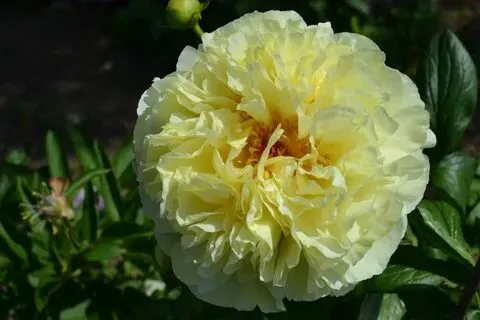
Light Requirements
Peonies, including the Lemon Chiffon variety, thrive in full sunlight. They require at least 6 hours of direct sunlight each day to ensure robust growth and prolific blooming. While they can tolerate partial shade, insufficient sunlight can lead to reduced flowering and leggy growth. Plant your Lemon Chiffon peony in a location where it will receive ample morning sunlight and some protection from the harsh afternoon sun.
Best Soil Mix
Well-drained, fertile soil is crucial for the healthy growth of Lemon Chiffon peonies. These plants prefer a slightly acidic to neutral pH (6.0 to 7.0). Amend heavy clay soils with organic matter such as compost or well-rotted manure to improve drainage and soil structure. Similarly, sandy soils can be enriched with organic material to enhance moisture retention. Avoid planting peonies in waterlogged soils, as this can lead to root rot and other fungal diseases.
Water Requirements
Consistent moisture is essential for the establishment and growth of Lemon Chiffon peonies. Water the plants deeply once a week, ensuring the soil remains evenly moist but not waterlogged. During periods of drought or extreme heat, increase the frequency of watering to prevent stress. Mulching around the base of the plants with organic material such as straw or bark chips can help retain soil moisture and suppress weeds.
Temperature and Humidity
Lemon Chiffon peonies are hardy perennials that can tolerate a range of temperatures. They perform best in temperate climates with cold winters, which are necessary for their dormancy and subsequent blooming. These peonies can withstand winter temperatures as low as -20°F (-29°C) when properly mulched. In warmer climates, providing some afternoon shade and adequate water can help prevent heat stress. Humidity is generally not a significant concern for peonies, but good air circulation around the plants can help prevent fungal diseases.
Fertilizer
To promote healthy growth and abundant blooms, fertilize your Lemon Chiffon peonies with a balanced, slow-release fertilizer in early spring, just as new growth begins to emerge. Avoid over-fertilizing, as excessive nutrients can lead to lush foliage at the expense of flowers. A second application of fertilizer can be made after flowering to support the plant’s energy reserves for the next growing season. Organic options such as compost or fish emulsion can also be used to enrich the soil.
Types of Lemon Chiffon Peony
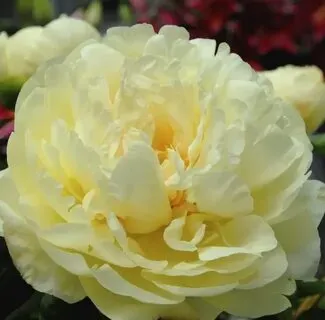
While the term “Lemon Chiffon peony” typically refers to a specific hybrid variety, there are several related cultivars and similar peony varieties that share comparable traits. These include:
- Lemon Dream: Another yellow peony variety with semi-double flowers and a slightly deeper yellow hue.
- Bartzella: A hybrid intersectional (Itoh) peony with large, bright yellow flowers and strong stems.
- Garden Treasure: Known for its vibrant yellow blooms and robust growth habit.
- Lemon Dream: A similar variety with slightly smaller blooms.
- Lemon Glow: Known for its bright, glowing yellow petals.
- Lemon Gem: A dwarf variety ideal for small gardens or containers.
Each of these varieties offers unique characteristics, but all share the common trait of striking yellow flowers that can brighten any garden.
Pruning Lemon Chiffon Peony
Proper pruning is essential to maintain the health and appearance of Lemon Chiffon peonies. Deadheading spent blooms can encourage further flowering and prevent the plant from wasting energy on seed production. In late fall, after the first frost, cut back the foliage to the ground level to reduce the risk of overwintering pests and diseases. Dispose of the pruned material to prevent the spread of any potential pathogens. Regularly removing any dead or diseased stems throughout the growing season can also help keep the plant healthy.
Expert Tips to Grow and Care for Buckeye Belle Peony
Propagating Lemon Chiffon Peony
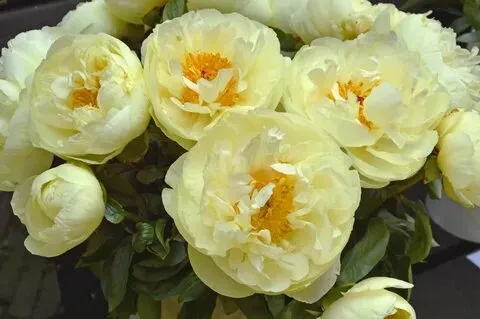
Propagation Methods
While there are a few ways to propagate peonies, division is the most common and successful method for Lemon Chiffon.
Division
Process:
- Dig Up the Plant: Carefully excavate the entire peony clump.
- Clean the Roots: Remove soil from the roots.
- Divide the Clump: Use a sharp, clean tool to separate the plant into sections. Each section should have at least three eyes (growth buds).
- Prepare Planting Holes: Dig holes as deep as the root system and twice as wide.
- Plant the Divisions: Position the crown of each division at soil level, cover with soil, and water thoroughly.
Cuttings (Less Common)
While less reliable, cuttings can be attempted under specific conditions.
- Best Time: Early summer when the plant is actively growing.
- Process:
- Select a Cutting: Choose a healthy, non-flowering stem with several nodes.
- Prepare the Cutting: Make a clean cut just below a node, removing leaves from the lower half.
- Dip in Rooting Hormone: Optional, but can increase success rates.
- Plant: Insert the cutting into a moist potting mix.
- Provide Humidity: Cover the cutting with a plastic bag to maintain humidity.
- Patience: Rooting can take several weeks.
Tips for Successful Propagation
- Soil Preparation: Ensure well-drained, fertile soil for optimal growth.
- Spacing: Plant divisions at least 3 feet apart to allow for adequate space.
- Watering: Water deeply and regularly, especially during the establishment phase.
- Patience: Peonies are long-lived plants, but it may take a few years for new divisions to bloom.
Potting and Repotting
Lemon Chiffon peonies can be grown in containers, although they typically prefer being planted in the ground. Choose a large, sturdy pot with adequate drainage holes. Use a high-quality potting mix with added compost for nutrients. Ensure the container is placed in a location that receives sufficient sunlight. Repotting may be necessary every 2-3 years to refresh the soil and provide more space for the growing root system. Handle the roots carefully during repotting to avoid damage.
Common Pests & Plant Diseases In Lemon Chiffon Peony
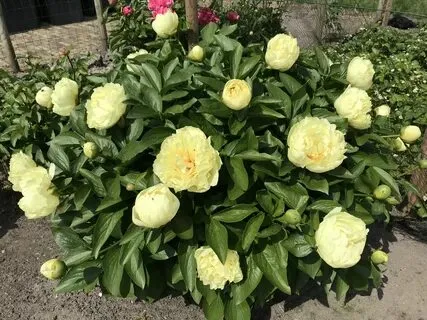
Pests
- Aphids: Small, sap-sucking insects that can cause stunted growth and deformed leaves. Treat infestations with insecticidal soap or neem oil.
- Thrips: Tiny insects that feed on flower buds, causing them to deform and fail to open. Control thrips with regular applications of insecticidal soap.
- Ants: While not harmful to the peonies themselves, ants are often attracted to the sugary secretions of aphids and can exacerbate aphid problems. Controlling aphids will help reduce ant presence.
Diseases
- Botrytis Blight: A fungal disease that causes gray mold on flowers and stems. Improve air circulation, avoid overhead watering, and remove affected plant parts to control the spread.
- Powdery Mildew: A common fungal disease that appears as a white, powdery coating on leaves. Increase air circulation, water at the base of the plant, and use fungicidal sprays if necessary.
- Phytophthora Blight: A serious fungal disease that causes wilting and blackened stems. Ensure good drainage and avoid overwatering to prevent this disease.
Troubleshooting Common Issues

Yellowing Leaves
Yellowing leaves In Lemon Chiffon Peony can be a sign of several issues, including overwatering, nutrient deficiencies, or pests. Check the soil moisture levels and adjust watering accordingly. A soil test can help identify nutrient imbalances that need to be corrected.
Poor Bloom Production
If your Lemon Chiffon Peony are not blooming well, it could be due to insufficient sunlight, overcrowding, or improper planting depth. Ensure your plants receive at least 6 hours of direct sunlight daily and thin out crowded plants to improve air circulation.
Wilting and Drooping
Wilting and drooping can result from underwatering, overwatering, or root damage. Check the soil moisture and adjust your watering practices. If the roots are damaged, carefully replant the peony and provide proper care to encourage recovery.
Seasonal Care Guide
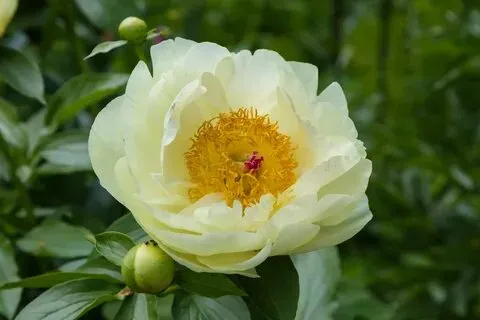
Spring Care
In early spring, remove any mulch from around the Lemon Chiffon Peony to allow new shoots to emerge. Apply a balanced fertilizer and inspect for pests and diseases. Support the plants with stakes or rings as they grow.
Summer Care
During summer, water the peonies regularly and mulch to retain soil moisture. Deadhead spent blooms and remove any diseased foliage. Continue to monitor for pests and diseases.
Fall Care
In the fall, cut back the foliage after it has died back. Divide and replant peonies if necessary. Apply a layer of mulch to protect the roots from winter cold.
Winter Care
In winter, ensure the peonies are well-mulched to protect them from freezing temperatures. Avoid disturbing the soil and refrain from watering unless there are prolonged dry periods.
Conclusion
Growing and caring for Lemon Chiffon peonies can be a rewarding experience, offering a stunning display of unique, lemon-yellow flowers. By understanding their specific care requirements, including light, soil, water, and temperature needs, you can cultivate healthy, vibrant plants that will thrive in your garden. Regular maintenance, including pruning, fertilizing, and monitoring for pests and diseases, will ensure your Lemon Chiffon peonies remain a focal point of beauty for years to come. Whether planted in the ground or grown in containers, these peonies are sure to add a touch of elegance and charm to any landscape.
